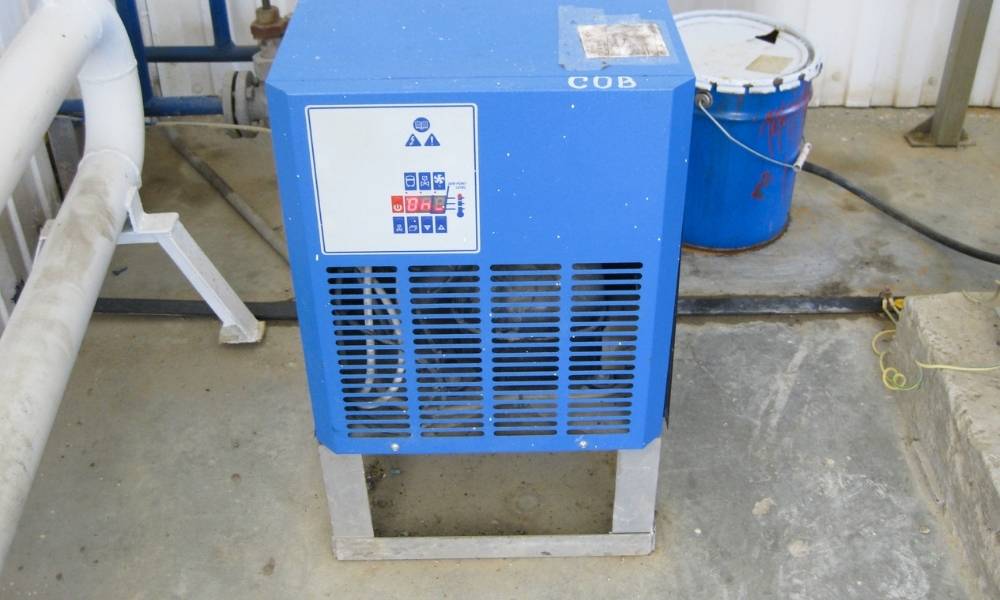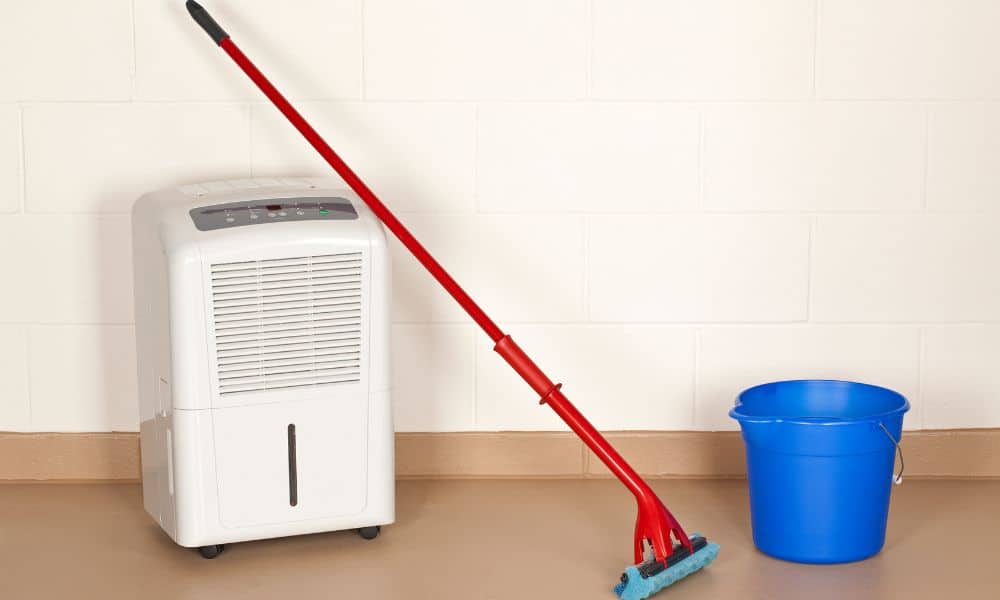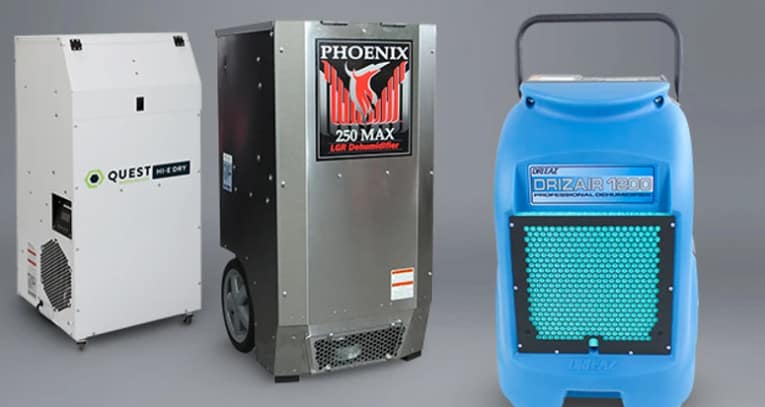If you have high humidity in your home, you should use a dehumidifier. These appliances remove moisture and help keep the desired humidity level. Maintaining a balanced humidity limits mold growth, reduces uncomfortable muggy conditions, and protects your home from damage.
Dehumidifiers are available in a variety of sizes and moisture removal capacities. Many models have a lot of good features that make your life easier. We have created this guide to help you understand how big and advanced a model you may need.
If you have high humidity in your home, using a dehumidifier can significantly improve your indoor air quality. These appliances remove excess moisture from the air, helping maintain a desired humidity level. Proper humidity control limits mold growth, reduces uncomfortable muggy conditions, and protects your home from damage. Dehumidifiers come in various sizes and capacities, and many models include features that enhance convenience and efficiency. This guide will help you understand how to choose the right dehumidifier for your needs.
Table of Contents
1. Understanding Humidity Levels
The ideal indoor humidity level is between 30% and 50%. Levels above this range can lead to mold growth, dust mites, and musty odors. A dehumidifier can help you achieve and maintain this ideal range, improving comfort and preventing structural damage.
2. Types of Dehumidifiers
There are several types of dehumidifiers to consider:
a. Refrigerant (Compressor) Dehumidifiers
These are the most common type and work by cooling air to remove moisture. They are highly effective in warm and humid conditions.
b. Desiccant Dehumidifiers
These use a desiccant material to absorb moisture from the air. They are effective in a wider range of temperatures, including cooler environments.
c. Thermoelectric (Peltier) Dehumidifiers
These are smaller and quieter, making them ideal for small spaces like bathrooms or closets. However, they are less efficient than refrigerant models.
3. Determining the Right Capacity
Dehumidifiers are rated by their capacity to remove moisture in pints per 24 hours. Here’s a general guide to help you choose the right capacity:
- Small (Up to 30 pints): Suitable for small rooms up to 500 square feet, like bathrooms or bedrooms.
- Medium (30-50 pints): Best for medium-sized areas between 500 to 1500 square feet, such as living rooms or basements.
- Large (50-70 pints): Ideal for large areas over 1500 square feet or extremely damp spaces.
4. Key Features to Consider
a. Humidistat
A built-in humidistat allows you to set and maintain a specific humidity level, providing greater control and efficiency.
b. Auto Restart
This feature ensures the dehumidifier resumes operation after a power outage, maintaining consistent humidity control.
c. Continuous Drainage
Models with a continuous drainage option can be connected to a hose for automatic water removal, eliminating the need to manually empty the water tank.
d. Energy Efficiency
Look for Energy Star-rated models, which consume less energy and can save you money on your utility bills.
e. Portability
Consider models with caster wheels and handles if you need to move the dehumidifier between rooms.
f. Noise Level
Check the noise level, especially if you plan to use the dehumidifier in a bedroom or living area. Quieter models are typically rated around 50 decibels or lower.
5. Additional Considerations
a. Maintenance
Regular maintenance is crucial for optimal performance. Choose models with washable filters and easy-to-access water tanks.
b. Brand and Warranty
Opt for reputable brands that offer good customer support and warranties. This ensures reliability and peace of mind.
c. Price
Dehumidifiers vary widely in price. Consider your budget, but also factor in long-term energy savings and durability when making your decision.
| Available | On | Amazon | ||
|---|---|---|---|---|
| TopAdd To Cart |  | Ivation | Prime | |
| Add To Cart |  | Ivation | PrimeEligible |
Why Should You Use A Dehumidifier
The recommended indoor humidity level is between 30 and 50 percent. If a humidity level is higher than 60 percent, then it is considered high, and you should reduce it by 30 to 50 percent. And the best way to reduce a humidity level is by using a dehumidifier.
Lowering humidity is not the only reason why you should use a dehumidifier. There are other reasons too.
They are preventing Mold and Mildew Growth. The best way to stop a mold or mildew before it even happens is to maintain a healthier humidity level. Mold and mildew spores grow and reproduce in warm, wet conditions above 60 percent. The areas that are sensitive to mold infestations are basements, bathrooms, and kitchens. Use a dehumidifier regularly in these areas to help keep them dry and mold-free.
These fungi can cause significant damage to your home and pose serious health risks. Areas particularly susceptible to mold infestations include basements, bathrooms, and kitchens. By maintaining a healthier humidity level, you can effectively prevent mold and mildew growth. Using a dehumidifier regularly in these sensitive areas helps keep them dry and mold-free, ensuring a safer and healthier living environment.
Managing Allergies. High moisture can increase common household allergy triggers like dust mites, mold spores, and airborne bacteria, which can grow and reproduce quickly in humid conditions. Keep humidity levels between 30 to 50 percent to make your space less hospitable to these allergy triggers and help you better manage your allergy symptoms. This can significantly help in managing allergy symptoms, providing relief for those who suffer from allergies and respiratory issues.
Pest Control. Moist conditions attract a variety of pests, including spiders, cockroaches, silverfish, and centipedes. These unwelcome critters thrive in damp environments. Using a dehumidifier to keep your home dry can repel these pests, making your living space less attractive to them. This not only helps in maintaining a cleaner home but also reduces the need for chemical pest control solutions.
Supplement Your Air Conditioner. Feeling chilly in your home lacks two things: excellent air and dry air. Apply a dehumidifier to increase your primary air conditioner to keep the air dry and save your AC from working overtime to reduce your humid space.
A dehumidifier can complement your air conditioner by helping to keep the air dry. When your home is too humid, your air conditioner has to work harder to remove the excess moisture, which can increase energy consumption and wear and tear on the unit. By using a dehumidifier, you can ease the burden on your air conditioner, potentially extending its lifespan and improving its efficiency. This can lead to a more comfortable indoor climate and energy savings.
Protecting Your Home. Excess moisture can cause significant damage to your home, affecting structural elements such as support beams, floorboards, and hardwood floors. High humidity can lead to issues like wood rot, warping, and buckling, which can result in costly repairs. By keeping the humidity level below 60 percent with the help of a dehumidifier, you can protect your home from moisture damage, preserving its integrity and value.
Ideal Place for a Dehumidifier

Dehumidifiers offer flexibility because of the variety of places in your home where you can place them.
When selecting a dehumidifier, it’s crucial to consider where you’ll place it. Different areas of your home can benefit significantly from reduced humidity levels. Here’s a guide to help you determine the ideal locations for your dehumidifier:
Basements
Basements are notorious for being damp or even wet, making them prime locations for dehumidifiers. Excess moisture in the basement can lead to mold growth, structural damage, and a general musty smell. A dehumidifier in the basement can help preserve your home’s foundation and maintain a healthier environment.
Bathrooms
Bathrooms are typically humid spaces, especially after hot showers. Without proper ventilation, this humidity can lead to mold and mildew, damaging walls, ceilings, and fixtures. Placing a dehumidifier in a poorly ventilated bathroom can significantly reduce moisture levels, keeping the space dry and mold-free.
Garages
Garages often suffer from dampness due to their exposure to the elements and lack of insulation. This can affect any items stored there and potentially damage the structure itself. A dehumidifier can help manage moisture levels, protecting tools, equipment, and the garage itself.
Spa and Indoor Pool Areas
While these areas usually have good ventilation systems, they can still benefit from a dehumidifier. High humidity levels can lead to mold and mildew growth, which can cause health issues and damage to the facilities. A dehumidifier can ensure that these areas remain comfortable and safe.
Water-Damaged Rooms
Any room that has suffered water damage is a candidate for a dehumidifier. Water-damaged areas are prone to mold and mildew, which can spread quickly if not addressed. Using a dehumidifier can help dry out the area and prevent further damage.
Other Places According to Your Own Needs
Consider placing dehumidifiers in any other areas of your home where humidity is a concern. This might include:
- Kitchens: Where cooking often produces steam and moisture.
- Laundry Rooms: Where dryers and washing machines contribute to higher humidity levels.
- Bedrooms: If you live in a particularly humid climate, a dehumidifier can help create a more comfortable sleeping environment.
Choosing the Right Dehumidifier
When selecting a dehumidifier, consider the following factors:
- Capacity: Choose a dehumidifier that matches the size of the room. Larger rooms or very damp areas will need a higher capacity unit.
- Energy Efficiency: Look for models with an Energy Star rating to save on electricity costs.
- Features: Consider additional features such as a built-in pump for continuous drainage, a hygrometer to measure humidity levels, and auto-restart functions for convenience.
How Do Dehumidifiers Work?
Through their operation, dehumidifiers remove water from the conditioned air.
Dehumidifiers operate by extracting water from the air, reducing humidity levels, and preventing the growth of mold and mildew. The process typically involves the following steps:
Refrigeration
The most common type of dehumidifier uses refrigeration technology. Here’s a detailed look at how this process works:
- Air Intake: A fan inside the dehumidifier draws in humid air through an inlet.
- Cooling Process: The humid air passes over cold coils or tubes filled with a coolant. As the air cools, the moisture in the air condenses into liquid water and drips off the tubes.
- Reheating: The now dehumidified air passes over a heating element, warming it back to its original temperature before it is expelled back into the room through the outlet.
- Water Collection: The condensed moisture collects in a bucket or reservoir at the bottom of the dehumidifier.
- Automatic Shut-Off: When the water bucket is full, the dehumidifier automatically turns off and activates an indicator light to alert you that the bucket needs to be emptied.
This refrigeration cycle continues, maintaining the desired humidity level in your room.
This is the most common type. A fan sucks moisture in through a dehumidifier inlet. A humid air passes over cold tubes through which a coolant circulates. As the air cools, the moisture it contains turns into liquid water and drops off the tubes.
The free moisture air passes over a heating element, warms back up to its original temperature, and blows back into the room through the outlet. The atmosphere’s moisture initially drops into a bucket at the bottom of the machine.
It automatically turns off and switches on an indicator light when it is a whole dehumidifier, telling you the device needs emptying.
Choosing the Right Dehumidifier
When selecting a dehumidifier, consider the following factors to ensure you choose the right one for your needs:
Room Size
Determine the size of the room where you’ll use the dehumidifier. Dehumidifiers are rated by the amount of moisture they can remove per day (measured in pints). For small rooms, a dehumidifier with a lower capacity may suffice, while larger rooms or particularly damp areas may require a higher-capacity unit.
Humidity Level
Assess the current humidity level in your space. If the humidity is extremely high, you may need a more powerful dehumidifier to achieve and maintain the desired humidity level.
Energy Efficiency
Look for dehumidifiers with the ENERGY STAR® label, which indicates they meet energy efficiency guidelines set by the Environmental Protection Agency (EPA). Energy-efficient models can save you money on electricity bills over time.
Noise Level
Consider the noise level of the dehumidifier, especially if you plan to use it in a bedroom or living area. Some models are designed to operate more quietly, providing a more comfortable environment.
Features and Controls
Modern dehumidifiers come with various features and controls to enhance convenience and performance, such as:
- Auto-Restart: Automatically resumes operation after a power outage.
- Adjustable Humidistat: Allows you to set the desired humidity level.
- Continuous Drain Option: Lets you attach a hose for continuous drainage, eliminating the need to empty the bucket manually.
- Timer: Enables you to set specific operating times, saving energy and optimizing performance.
Portability
If you plan to move the dehumidifier between rooms, consider a model with caster wheels and a lightweight design for easy mobility.
Maintenance
Regular maintenance is crucial for optimal performance. Choose a dehumidifier with accessible filters and a removable water bucket for easy cleaning and maintenance.
| Available | On | Amazon | ||
|---|---|---|---|---|
| TopAdd To Cart |  | Ivation | Prime | |
| Add To Cart |  | Ivation | PrimeEligible |
Which Type of Dehumidifier Do You Need?
Dehumidifiers are available in 2 main types: residential and commercial/industrial models.
Residential dehumidifiers

For separate spaces like basements or bathrooms, the best are residential dehumidifiers. They are portable and available in small, medium, and large moisture removal capacities. Usually, these dehumidifiers have many features such as electronic control panels, multiple fan speeds, casters, onboard humidistats, water buckets, and maybe Energy Star-qualified.
Types of Residential Dehumidifiers
Portable Dehumidifiers: Ideal for individual spaces like basements, bathrooms, or bedrooms, portable dehumidifiers come in various sizes to suit different moisture removal needs. They are categorized as small, medium, and large capacity units.
Features to Look For
- Electronic Control Panels: Simplifies the operation of the dehumidifier with easy-to-use interfaces.
- Multiple Fan Speeds: Offers flexibility in the dehumidification process, allowing for adjustments based on humidity levels.
- Casters: Enhances portability, making it easier to move the unit from one room to another.
- Onboard Humidistats: Automatically monitors and maintains desired humidity levels.
- Water Buckets: Collects the extracted moisture, which needs to be emptied periodically.
- Energy Star-Qualified: Indicates energy efficiency, leading to lower operating costs and environmental impact.
Whole House Dehumidifiers
For whole home needs, you can use a whole-home dehumidifier. They are connected to the HVAC system and dehumidify the air as it’s cooled. Dry, cool air is dispersed everywhere in your home through your ductwork.
You may also choose standalone whole-house dehumidifiers. They are portable and easy to set up and operate. It’s critical to place them in a centralized location in the practice space for the most efficient dehumidifying.
Types of Whole House Dehumidifiers
- Integrated Units: Connected directly to the HVAC system, ensuring consistent humidity control across the entire home.
- Standalone Units: Portable and easy to set up, these dehumidifiers should be placed in a centralized location for optimal performance.
Commercial/industrial dehumidifiers
Commercial dehumidifiers are bigger and heavier-duty units made for more unforgiving dehumidifying jobs. These dehumidifiers have huge moisture removal capacities and can operate in extreme conditions.
These models have low-temperature operation internal condensate pumps, loss of power protection, and simplified controls. You might use an industrial dehumidifier to help remove moisture in a flood-damaged space or control humidity in an indoor pool area.
Some small industrial models are also more effective choices for residential basements and crawl spaces.
Purpose and Use
Designed for more demanding dehumidification tasks, commercial and industrial dehumidifiers are built to handle extreme conditions and large-scale moisture removal.
Features of Commercial/Industrial Dehumidifiers
- High Moisture Removal Capacities: Capable of extracting significant amounts of moisture, suitable for large or severely damp areas.
- Low-Temperature Operation: Effective in environments where temperatures are low, ensuring continuous dehumidification.
- Internal Condensate Pumps: Facilitates the removal of collected water, minimizing maintenance needs.
- Loss of Power Protection: Automatically resumes operation after a power outage, preserving settings and ensuring consistent performance.
- Simplified Controls: User-friendly interfaces that streamline operation even in challenging conditions.
Applications
- Flood Damage Restoration: Essential for removing moisture and preventing mold growth in flood-affected areas.
- Indoor Pool Areas: Controls humidity to prevent structural damage and maintain air quality.
- Basements and Crawl Spaces: Smaller industrial models can be effective for residential use in particularly damp or large spaces.
| Available | On | Amazon | ||
|---|---|---|---|---|
| TopAdd To Cart |  | Frigidaire | PrimeEligible | |
| Add To Cart |  | KEYSTONE | Prime |
Choosing the Perfect Size Dehumidifier
Dehumidifier manufacturers show pints as capacity: the more pints, the better the performance.
For example, 40 points mean that the dehumidifier can remove 40 pints of moisture daily.
All dehumidifiers have stated how many pints of water they can remove.
You may question how to know if you need, for example, 30 pints per day or 70 pints? You can convert pints to square feet. But to do that, you must know at least how damp your space is. Is it only a little damp, moderately damp, or highly wet?
A little damp space has 50 to 60 percent humidity. It feels damp and has an occasional musty smell.
Moderately damp space often feels damp and often smells musty. The humidity level is between 60 and 70 percent.
The very damp place feels wet and musty; damp spots appear on the walls and floors. Humidity is between 70 to 85 percent.
Extremely wet space feels wet, smells musty; seepage appears on walls and floors; may have mold growth. Humidity is between 85 and 100 percent.
To help simplify your selection in size, take a look at the sizing chart below:
|
The condition |
Up to 500 |
501-1000 |
1001-1500 |
1501-2000 |
2001+ sq. |
|
A little damp 50-60% |
20 pints |
25 pints |
35 pints |
45 pints |
60+ pints |
|
Moderately damp 60-70% |
25 pints |
30 pints |
40 pints |
55 pints |
70+ pints |
|
Very damp 70-85% |
30 pints |
35 pints |
50 pints |
65 pints |
80+ pints |
|
Extremely wet 85-100% |
35 pints |
40 pints |
60pints |
75 pints |
90+ pints |
Capacity at AHAM vs. Capacity at Saturation
There are two ways of testing conditions for manufacturers to rate their dehumidifiers’ moisture removal capacities. The words AHAM and saturation refer to the circumstances in which dehumidifiers are tested.
AHAM grades are registered at average conditions of 60 percent humidity and 80 degrees Fahrenheit. These measurement circumstances are what the Association of Home Appliance Manufacturers suggests. AHAM conditions are supposed to give the most realistic representation of how a dehumidifier will work. The testing circumstances are so close to what most homes and structures will experience.
A saturation rating is recorded at 90 percent humidity and 90 degrees Fahrenheit, which serve much more intense conditions that won’t usually be experienced in the area.
Why should we test in situations that are rarely encountered?
Because measuring at saturation attends measure near the maximum volume of moisture, a presented unit can be obtained in a single day. It’s similar to describing a car’s top speed as a notice of overall achievement.
This makes a dehumidifier choice a bit complicated. Because when you search for a dehumidifier, you have to consider the testing conditions each model might have been rated in.
A dehumidifier that can remove 90 pints of water in saturation conditions (100% humidity) will only remove around 50 pints of water in AHAM conditions (60% humidity). That is because a dehumidifier extracts less water in the drier air than in more humid conditions.
Be sure to keep testing conditions in mind when you’re judging models. If you search for a dehumidifier for very wet space, look for a tested unit at AHAM. It will be more robust than a model rated at saturation.
Draining Dehumidifier
Dehumidifiers with refrigeration systems collect moisture and have to get rid of it somehow. Most dehumidifiers have buckets as the primary draining method, but there are other ways to get rid of it.
- As you may already know, most dehumidifiers come with a bucket or water reservoir. It’s effortless to empty a full bucket, but you have to do that very often, depending on how humid your space is. Most dehumidifiers come with smaller buckets than they can collect in a day. So if your area is very humid, avoid this method and keep reading below about other methods.
- Gravity Drain. This is the second most often used method to remove collected water. If the dehumidifier has a draining hose port, you can attach a hose to it and automatically let the dehumidifier water out. You can use various types of hoses. Keep in mind that most sellers don’t include them. The cons of this method are that you can’t move water upwards. And it would help if you put the other hose end somewhere.
- Internal Condensate Pump. The best method, in my opinion. This is what I call: set it and forget it. This method works only if a dehumidifier has this option. With this method, you can add a hose and pump water whenever you want – upwards outside the window, in your sink, or whenever you want. A dehumidifier will pump away the collected moisture automatically.
External Condensate Pumps
If a dehumidifier is equipped with a gravity drain, it can be used with an external condensate pump. This special accessory works as an internal condensate pump, pumping moisture out of the water reservoir. You must attach a hose from the gravity drain port on the dehumidifier to the pump. Then, you have to route another pipe from the pump to your chosen draining location.
Features to Look For
Almost all dehumidifiers have many features to add comfort to your life and help the unit best fit your needs. Most of the popular features you can see below:
Automatic Humidistat. Best feature out there. A humidistat automatically maintains your desired humidity level by triggering the dehumidifier to run only when needed. It helps to save energy.
Programmable Timer lets you program startup and shutoff times. Great if you don’t have time to turn it on or off.
Various Operating Modes and Speeds – Pick from multiple speeds and modes to find the best level of dehumidification for your needs.
Casters and Handles. Most dehumidifiers are quite large, which is why they have casters and handles. Also, almost all of the units which have water containers have them with handles.
Automatic Restart. The dehumidifier automatically restarts on power failure. Great feature.
Low-Temperature Operation. Most residential dehumidifiers operate successfully down to 41 degrees F. Look for this feature if you use your unit in a cooler crawl space or basement.
Automatic Defrost. In freezing temperatures, automatic defrost helps maintain your unit operational by defrosting any ice accumulation to reduce downtime.
Air Filter. Most household dehumidifiers have a washable air filter that catches allergens and particles and protects the unit’s internal components from debris damage.
Dehumidifier Noise Level
Most dehumidifiers, especially those with compressors and fans, work by moving air through them. And this process can be quiet only when moving a low amount of air.
As soon as these dehumidifiers start to move a decent amount of air, they become noisy.
How loud this noise will depend on the model. Some have a quiet operation (at least they present them as quiet). With these models, manufacturers have taken several steps to reduce noise by isolating the fan or using a smoother-running fan, for example.
The dehumidifier noise level is measured in decibels (dB). Most dehumidifiers are loud when working, but the good news is that 90% of the time, you don’t use them in spaces where you spend most of your time.
Fan Operation
A dehumidifier with a fan has two operation possibilities. One is when a dehumidifier fan runs continuously, and one is when the system is actively dehumidifying. Which is the best and more efficient? Read further.
Continuously fan run time. The fan is constantly on whether the compressor is running or not. With this operation, the fan helps move air always through the humidity sensor (if equipped) so that the dehumidifier measures the correct humidity level in the room.
This option helps a dehumidifier set the fan speed and consistently maintain your desired humidity level. Air is being dehumidified very effectively. Minus with a running fan is that it consumes more energy.
Fan Runtime Only When Dehumidifying. When the compressor turns off, also the fan turns off. It saves energy because the fan doesn’t run without a need and helps secure the system more efficiently.
So you still don’t understand which is more efficient? Because dehumidifiers with fans that run only when dehumidifying only save a small amount of energy, we would choose a dehumidifier with a continuous running fan. These models will more accurately sense your room’s humidity level and adjust operation accordingly, so you’ll get the best results and stay within your energy budget.
Dehumidifier Maintenance

Usually, dehumidifiers are trouble-free, but they do require maintenance. You will have to empty the water tank and clean the unit periodically to keep your home free of extra moisture, dust, and air pollutants such as mold and mildew that can harm your health. That will also help prolong your dehumidifier life and overall performance.
Here are some tips for better maintenance:
- Place your dehumidifier at least 6 inches (15.24 centimeters) apart from a wall so it does not block the air inlet or outlet.
- Close doors and windows. Keeping your doors and windows open will decrease your dehumidifier’s effectiveness in that area and may also raise your energy bill.
- Wait for at least 10 minutes to power your dehumidifier back on after turning it off. Some dehumidifiers have an automatic time delay before they start running again. Powering your dehumidifier off and on right away may cause your dehumidifier’s compressor to overheat.
- Clean the dehumidifier regularly. If it has a filter, clean it at least once per year. Clean the filter as the manufacturer has stated in the user manual.
- When emptying a water tank, scrub the inside with a brush using soap and water or use a disinfectant spray and paper towels.
- Oil your dehumidifier’s fan motor regularly using three drops of lubricating oil to keep your fan running smoothly and quietly.
- Dehumidifiers can last from 3 to 15 years. Performing the recommended maintenance and keeping your unit in excellent condition improves and lengthens the operating lifespan.
Add To Cart 
Aprilaire PrimeEligible Add To Cart 
ALORAIR PrimeEligible Add To Cart 
Aprilaire Prime Add To Cart 
Kazravan Enterprises LLC PrimeEligible




